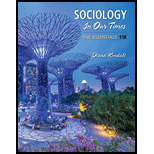
Introduction
Sociology helps us study social ties between individuals and society. When a society’s social ties are weakened, people feel more stress and may become hopeless. This stress from a weaker social fabric is compounded when one feels anxiety on the job and pressure to do well and take care of the family back home. The aggregate effect of these stressors can lead people to feel that ending their lives would be an option preferable to continuing to live and face the challenges, particularly when solutions are hard to appreciate.
Explanation of Solution
Answer and explanation
Emile Durkheim said that the bonds between people get slack when the social fabric of society is weakened. Having to move to the city to get a job, even in boom times, is a stressful choice and a person may feel detached from their social support system. Sociology provides the means by which this phenomenon can be studied and hopefully remedied. A worker who leaves home for work may feel pressure to do very well in order to make the family proud and earn enough money to help support the rest of their relatives who stayed home. The worker may send money home and still face escalating expectations from family, if the family perceives that the economy is doing well and their money demands increase accordingly. Feelings of failure, a sense that one has let their family down, and an inability to see solutions to very real and frightening problems can lead to an increase in suicidality. The protective factors that can insulate one from suicidal impulses may also erode as social support systems become less present and reliable.
Want to see more full solutions like this?
Chapter 1 Solutions
Sociology in Our Times: The Essentials (MindTap Course List)
- Leisure and Your Own Life How have your thoughts on leisure changed because of this course? Identify at least one change that you have made or plan on making in regard to your own approach to leisure and well-being. In addition, please read the paper and listen to the audio “This is Water” by David Foster Wallace and give three points, which struck you as important in regards to leisure and how you think about it at the end of the course, opposed to prior to the course.arrow_forwardConsider the issue of active voluntary euthanasia. How would a person argue against this practice using utilitarianism? In your response, discuss both the strengths and weaknesses of this theory.arrow_forward. Is there ever an instance in which cheating is ethical? In your answer, apply ethical principles and/or theories to support your answer.arrow_forward
- humanized/short answers each What are some characteristics of students with EBD? How is EBD defined, and what role might systemic racism and implicit bias play in identification of students with EBD? How does the information processing model (IPM) help us understand the strengths and challenges of students with EBD? What educational responses are needed to help address the strengths and challenges of students with EBD? What does “wrap-around support” look like? What roles can family and community play in supporting children and youth with EBD across their life course?arrow_forwardWhy do females commit fewer crimes than males? Please include references.arrow_forwardDescribe the types of murders, assaults, and robberies. Please include references.arrow_forward
- How do chapters 1-7 of Invisible Man capture the significance of Black literary tradition as a mode of making oppression visible? What are the different ways in which people "see" or "not see" the narrator? Follow MLA documentation style, correctly cite your chosen passage and any other quotations from the text that support your interpretations and claimsarrow_forwardCan I have help strengthening this essay. 1. The Sapir-Whorf hypothesis, also known as linguistic relativity, suggests that language shapes our perception of reality and influences how we think. This aligns with the idea that language impacts how we understand gender, race, and ethnicity. For example, gendered languages, such as Spanish and French, may reinforce traditional gender roles through the ways nouns and pronouns are assigned. Similarly, the terminology used to describe racial and ethnic groups can shape societal attitudes and reinforce stereotypes. Words and phrases carry cultural meanings that influence how individuals perceive themselves and others, demonstrating that language plays a significant role in shaping social reality. 2. Culture shock occurs when individuals encounter a culture vastly different from their own, leading to feelings of confusion, anxiety, or even alienation. If a person from the 1860s time-traveled to modern America, they would likely be shocked…arrow_forwardHow can drought be triggeredarrow_forward
- Please explain each of the following goals of political criminals: Intimidation Revolution Profit Conviction Pseudo-conviction Please provide references.arrow_forwardDiscuss Chapter 2 of Barry Glassner’s “The Culture of Fear.” Students may address but are not limited to discussing how the media covers crime, specific case studies mentioned in the chapter such as that of Anthony Riggs, and explanations provided by media outlets for media assertions.arrow_forwardExplain the five primary goals of political criminals. Please include references.arrow_forward
 Social Psychology (10th Edition)SociologyISBN:9780134641287Author:Elliot Aronson, Timothy D. Wilson, Robin M. Akert, Samuel R. SommersPublisher:Pearson College Div
Social Psychology (10th Edition)SociologyISBN:9780134641287Author:Elliot Aronson, Timothy D. Wilson, Robin M. Akert, Samuel R. SommersPublisher:Pearson College Div Introduction to Sociology (Eleventh Edition)SociologyISBN:9780393639407Author:Deborah Carr, Anthony Giddens, Mitchell Duneier, Richard P. AppelbaumPublisher:W. W. Norton & Company
Introduction to Sociology (Eleventh Edition)SociologyISBN:9780393639407Author:Deborah Carr, Anthony Giddens, Mitchell Duneier, Richard P. AppelbaumPublisher:W. W. Norton & Company The Basics of Social Research (MindTap Course Lis...SociologyISBN:9781305503076Author:Earl R. BabbiePublisher:Cengage Learning
The Basics of Social Research (MindTap Course Lis...SociologyISBN:9781305503076Author:Earl R. BabbiePublisher:Cengage Learning Criminalistics: An Introduction to Forensic Scien...SociologyISBN:9780134477596Author:Saferstein, RichardPublisher:PEARSON
Criminalistics: An Introduction to Forensic Scien...SociologyISBN:9780134477596Author:Saferstein, RichardPublisher:PEARSON Sociology: A Down-to-Earth Approach (13th Edition)SociologyISBN:9780134205571Author:James M. HenslinPublisher:PEARSON
Sociology: A Down-to-Earth Approach (13th Edition)SociologyISBN:9780134205571Author:James M. HenslinPublisher:PEARSON Society: The Basics (14th Edition)SociologyISBN:9780134206325Author:John J. MacionisPublisher:PEARSON
Society: The Basics (14th Edition)SociologyISBN:9780134206325Author:John J. MacionisPublisher:PEARSON





